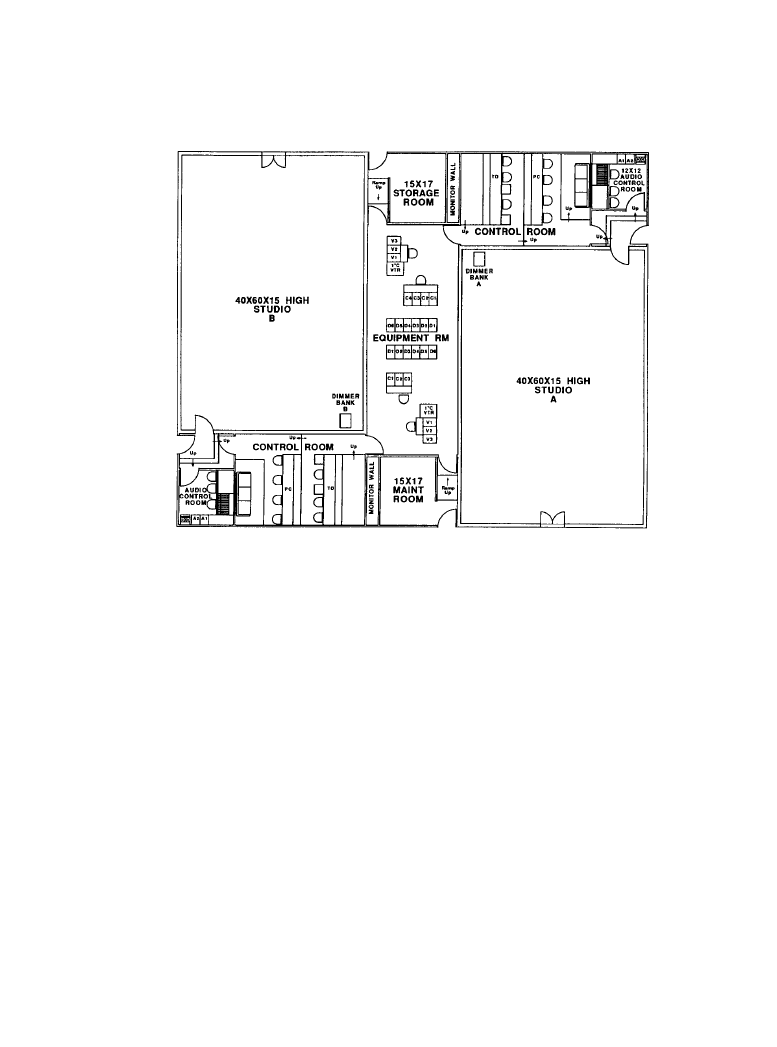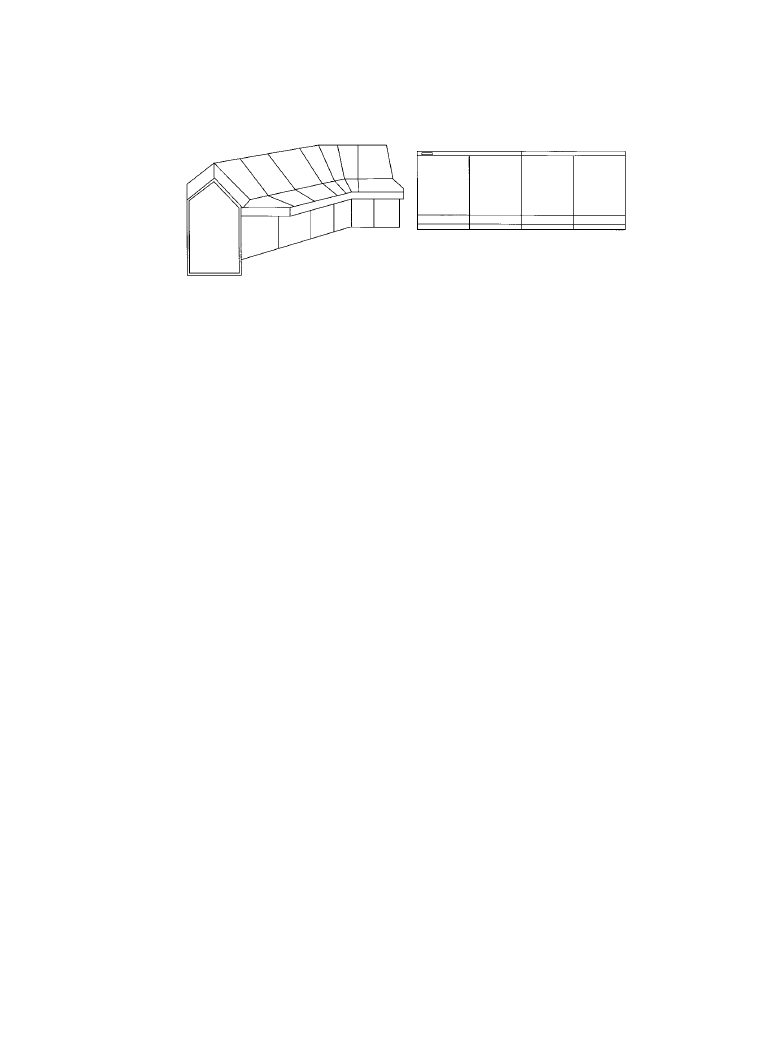ВУЗ: Казахская Национальная Академия Искусств им. Т. Жургенова
Категория: Книга
Дисциплина: Не указана
Добавлен: 03.02.2019
Просмотров: 21699
Скачиваний: 19

10-24 Audio Production Standards, Equipment, and System Design
Preliminary Space Planning
Whether the project involves new construction or renovation of an existing building, current
facilities and equipment are reviewed to determine a starting point for the planning process.
Building and room layouts are determined by studying each function and its relationship to all
others. Functional requirements of each operational department are assessed to determine the
gross space requirements of areas to be expanded or renovated. Key facility personnel are inter-
viewed to determine past experiences, future trends, operational requirements for immediate use,
and future needs of the facility. This should include the number of present employees and those
anticipated in the future.
Environmental factors, such as noise, vibration, RF interference, power line interference, tem-
perature, and humidity also must be considered. Accessibility to utilities, such as communica-
tions, power, air supply, fuel, and water, must be calculated. Air conditioning is a major concern
in all large facilities that employ a lot of equipment or lighting.
After management approves the equipment list, a rough schematic layout is prepared in con-
junction with the architect’s preliminary drawings. The system engineer examines this layout to
be certain that it provides adequate space for present and future equipment and for maintenance
and operation. Equipment identification is then added to the architect’s schematic, and the proce-
Figure 10.2.3
Architectural floor plan of a new facility.
Downloaded from Digital Engineering Library @ McGraw-Hill (www.digitalengineeringlibrary.com)
Copyright © 2004 The McGraw-Hill Companies. All rights reserved.
Any use is subject to the Terms of Use as given at the website.
Production Facility Design

Production Facility Design 10-25
dure continues to the design-development phase. An example of an architectural floor plan is
shown in Figure 10.2.3. Equipment placement in rack assemblies is illustrated in Figure 10.2.4.
Design renderings (drawings or paintings created by an artist or drafter to show a realistic flat
or perspective view of a design) are then produced. Full-color 3-D models can be generated by a
computer for viewing from different perspectives. The printout of any view can be used as the
rendering.
A color and materials presentation board is usually prepared for review by decision makers.
The presentation may include the following:
•
Artist or computer renderings
•
Color chips
•
Wood types
•
Work surface laminates
•
Metal samples
•
Samples of carpeting, furniture fabrics, and wall coverings
Several different combinations may be prepared. The samples and renderings are attached to a
board or heavy paper stock for easy presentation.
Figure 10.2.4
Equipment placement in a rack assembly.
Downloaded from Digital Engineering Library @ McGraw-Hill (www.digitalengineeringlibrary.com)
Copyright © 2004 The McGraw-Hill Companies. All rights reserved.
Any use is subject to the Terms of Use as given at the website.
Production Facility Design

10-26 Audio Production Standards, Equipment, and System Design
Design Models and Mockups
When a drawing cannot be interpreted easily by the owner and/or staff, a scale model or full-size
mockup of the facility (or portions of it) can be constructed. This will help familiarize them with
the design, allowing them to make decisions and changes. Models can also be used to present a
design concept to company executives. Models can provide a cost-effective way to evaluate new
ideas. Inexpensive materials can be formed to represent racks, consoles, or equipment. For exam-
ple, the top and four side views of an enclosure can be drawn or plotted at a reduced scale on stiff
paper so that the drawings touch at adjoining surfaces. When cut out, they are glued together to
form a 3-D model. Flaps added to the drawing make it easier to join the surfaces. The more detail
provided in the mockup, the better.
Blocks of wood can also be cut to the shape of the equipment being modeled. Cut-out draw-
ings of the equipment features are pasted on the block’s surfaces to add realism. Plastic scale
models of structural components, piping, furniture, and other elements are available from model
manufacturers and can be used to enhance the presentation.
Full-scale mockups, like models, can be built using any combination of construction materi-
als. Stiff foam board is a relatively easy and inexpensive material to use to prepare full-size mod-
els. Pieces can be cut to any shape and joined to form 3-D models of racks, consoles, and
equipment. (See Figure 10.2.5.) Actual-size drawings of equipment outlines, or more detailed
representations, can then be pasted in place on the surfaces of the mockup.
10.2.3e
Construction Considerations
Demolition and construction of existing structures may have to be specified by the system engi-
neer. Electrical power, lighting, and air conditioning requirements must be identified and layout
drawings prepared for use by the electrical and mechanical engineering consultants and the
architect.
During preparation of final construction documents, the architect and the system engineer
can confirm the layout of technical equipment wire ways, including access to flooring, conduits,
trenches, and overhead raceways. At this point, the system engineer also provides layouts of
cable runs and connections. This makes equipment installation and future changes much easier.
An overhead cable routing plan is shown in Figure 10.2.6.
When it is necessary to install ac power cables in conduit, follow National Electrical Code
(NEC) requirements for conduit fill and the number of pull boxes. More pull boxes or larger con-
Figure 10.2.5
Equipment rack and console mockup for planning purposes.
Downloaded from Digital Engineering Library @ McGraw-Hill (www.digitalengineeringlibrary.com)
Copyright © 2004 The McGraw-Hill Companies. All rights reserved.
Any use is subject to the Terms of Use as given at the website.
Production Facility Design

Production Facility Design 10-27
duit is required in conduit runs that have many bends. Specify direct-burial-type cable when the
conduit or cable trays are underground, and where there is a possibility of standing water. Con-
duit and cable trays should be designed to accommodate the minimum bend radius requirements
for the cables being used.
Debur and remove all sharp edges and splinters from installed conduit. Remove construction
debris from inside the lines to prevent damage to the cable jacket during pulling. Cover openings
to the conduit to prevent contamination or damage from other construction activities. If the cable
is damaged during pulling, moisture could enter the cable.
10.2.3f
Component Selection and Installation
Equipment selection is normally based on the function it will perform. User input about opera-
tional ease and flexibility of certain models is also important. However, to ensure that the most
cost-effective choice is made, consider certain technical issues before making a decision. The
system engineer should research, test (when required), and provide the technical input needed for
selecting hardware and software.
Equipment features and functional capabilities are probably the main concerns of the users
and management. Technical performance data and specifications are important considerations
that should be contributed by the system engineer during the selection process. For a piece of
equipment to qualify, technical specifications must be checked to ensure that they meet set stan-
dards for the overall system. Newly introduced products should be tested and compared before a
Figure 10.2.6
Cable wire routing plan for a new facility.
Downloaded from Digital Engineering Library @ McGraw-Hill (www.digitalengineeringlibrary.com)
Copyright © 2004 The McGraw-Hill Companies. All rights reserved.
Any use is subject to the Terms of Use as given at the website.
Production Facility Design

10-28 Audio Production Standards, Equipment, and System Design
decision is made. The experienced system engineer can test and measure the equipment to evalu-
ate its performance.
A simple visual inspection inside a piece of equipment by an experienced technician or engi-
neer can uncover possible weaknesses, design flaws, and problem areas that may affect reliability
or make maintenance difficult. It is therefore advisable to request a sample of the equipment for
evaluation before committing to its use.
The availability of replacement parts is another important consideration when specifying
products. A business that depends on its equipment functioning to specifications requires that
the service technician be able to make repairs when needed in a timely manner. Learn about
manufacturer replacement parts policies and their reliability. When possible, select equipment
that uses standard off-the-shelf components that are available from multiple sources. Avoid
equipment that incorporates custom components that are available only from the equipment
manufacturer. This will make it easier to acquire replacements, and the cost of the parts will—
most likely—be less.
When possible, specify products manufactured by the same company. Avoid mixing brands.
Maintenance technicians will more easily become familiar with equipment maintenance, and
experience gained while repairing one piece of hardware can be directly applied to another of the
same model. Service manuals published by the same manufacturer will be similar and therefore
easier to understand and use to locate the information or diagram needed for a repair.
Commonality of replacement parts will keep the parts inventory requirements and the inven-
tory cost low. Because the technical staff will be dealing with the manufacturer on a regular
basis, familiarity with the company’s representatives makes it easier to get technical support
quickly.
Sometimes components are selected that are not really compatible, such as differing signal
levels or impedances. The responsibility then falls on the system engineer to devise a fix to make
that component compatible with the rest of the system. The component may have been originally
selected because of its low price, but additional components, engineering, and labor costs often
offset the expected savings. Extra wiring and components can also clutter the equipment enclo-
sure, hampering access to the equipment inside. Nonstandard mounting facilities on equipment
can add unnecessary cost and can result in a less than elegant solution.
10.2.3g
Technical Documentation
Engineering documentation describes the practices and procedures used within the industry to
specify a design and communicate the design requirements to technicians and contractors. Docu-
mentation preparation should include, but not be limited to, the generation of technical system
flow diagrams, material and parts lists, custom item fabrication drawings, and rack and console
elevations. The required documents include the following:
•
Documentation schedule
•
Signal flow diagram
•
Equipment schedule
•
Cable schedule
•
Patch panel assignment schedule
•
Rack elevation drawing
Downloaded from Digital Engineering Library @ McGraw-Hill (www.digitalengineeringlibrary.com)
Copyright © 2004 The McGraw-Hill Companies. All rights reserved.
Any use is subject to the Terms of Use as given at the website.
Production Facility Design